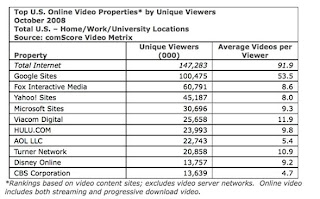According to October data from ComScore and reported by MarketingCharts, “More than 147 million US internet users watched an average of 92 videos per viewer in October.” That’s incredible! The article goes on to say:
• 77% of the total US internet audience viewed online video.
• The average online video viewer watched 274 minutes of video.
Yes, young people 18 – 34 watch more, but we’re all watching them. Here are the charts for number of videos and number of unique viewers.

Hulu, with its emphasis on “long form” video is coming up fast. When I ask groups how many have watched videos lately, everyone says yes. And a lot of them respond that they are watching video of things they weren’t able to see live—time shifting. A final observational note; if you haven’t signed up for a YouTube video channel just to see how a channel works (and think about how it could work for marketers), sign up for the President-Elect’s transition channel and see how they are using it and experience a channel. Don’t worry—you can unsubscribe later, but the fact is, YouTube only sends me an update once a week. A setting probably—I don’t remember--but the point is that it’s not obnoxious.
Back to the point, which is meaningful metrics to understand and learn to make use of all this video that’s going back and forth in cyberspace.
ComScore measures traditional metrics with panel data. As you see from the charts, the basic metrics are:
• Total unique viewers and number of videos viewed
• Engagement metrics such as duration and videos per viewer
• Key demographic statistics for viewers of online video by site and category
If you want to know more, they have good video demos.
Quantcast, which describes itself as “a new breed of measurement service helping buyers and sellers quantify the characteristics of digital audiences against which they can activate addressable advertising solutions.” Translate that: they measure directly, by getting publishers to sign up with them and allow their site traffic to be monitored.
That’s what they’ve done with video. MTV Networks has over 350 digital properties, with the largest and best known including MTV.com, VH1.com, Nickelodeon.com, and ComedyCentral.com, The addition of all these sites to Quantcast’s network of directly-measured properties will certainly add to their ability to provide metrics in the rapidly-growing video field.
Interested in the differences between ComScore and Quantcast data? There’s been some back-and-forth in the blogosphere. Here’s ComScore’s statement and Quantcast’s reply.
The arguments about how best to measure key metrics has been going on since the dawn of mass media, and it continues into interactive media. New developments in metrics are important to all marketers, and we need to keep track of what’s going on!
Thursday, December 11, 2008
New Video Metrics
Posted by MaryLou Roberts at 10:32 AM
Labels: Quantcast, social media metrics, video, web metrics, YouTube
Subscribe to:
Post Comments (Atom)



2 comments:
After reading this post about video metrics, I decided to have a look at Hulu. It turns out that you can't watch clips on Hulu if you are outside the US: "Hulu is an online video service ... in the U.S" (from the About page) and "For now, Hulu is a U.S. service only. That said, our intention is to make Hulu's growing content lineup available worldwide. This requires clearing the rights for each show or film in each specific geography and will take time." (from the FAQ page). So, for example, I can't watch Hugh Laurie in SNL on Hulu (which I would love to see). However, I can watch single sketches on youtube where one of the posters added the following to the video's information: "SNL is owned by NBC. No copyright infringement intended." (Is that enough, legally speaking?)
I have been similarly frustrated trying to watch BBC video content online on the BBC's iPlayer (www.bbc.co.uk/iplayer). The iPlayer offers BBC's TV programming from the last week online. On my TV at home I can watch BBC programmes from the UK (which I pay for through my cable subscription) but nevertheless, I cannot watch them on the iPlayer. Interestingly, I can listen to BBC radio programmes, news programmes and sports programmes through the iPlayer.
It seems that legal issues are seriously impeding these content publishers in their attempts to share video on a global scale, while at the same time, individuals can quite easily share that same content with others across the globe (perhaps taking a legal risk at the same time). It seems to me that we all have an urgent need for a new legal framework that accomodates the online reality that we all use on a daily basis.
Of course another explanation could be that broadcasters don't really want to share this content across the globe!
That's interesting, Ailsa. There probably are different laws in different countries that impede video sharing. That doesn't seem the best situation for marketers who'd like to have their content seen, as far as I can tell.
MLR
Post a Comment